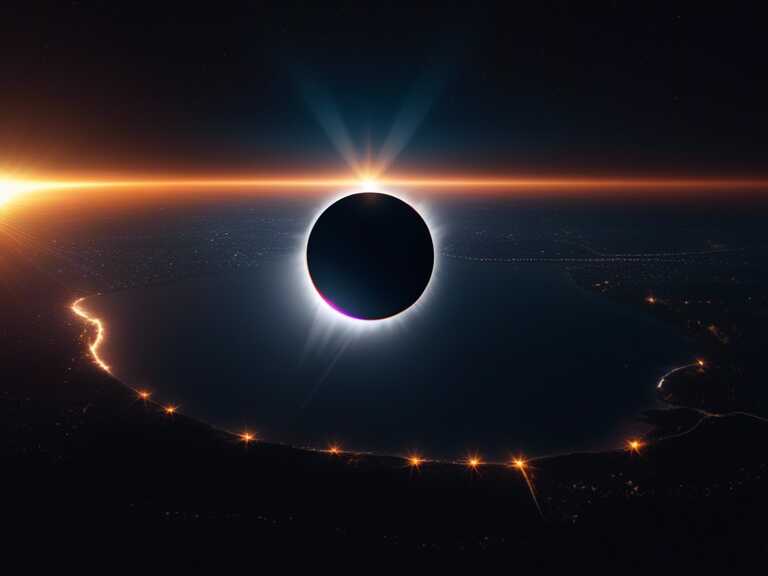
2024 Total Solar Eclipse: Path of Totality, Start Time, Peak, and End Locations
The 2024 solar eclipse will be visible across North America, from Mexico to Canada, with varying durations of totality and percentages of sun coverage.

2024 Solar Eclipse: A Celestial Phenomenon Sweeping Across North America
Today, millions of people across North America are eagerly anticipating the extraordinary celestial event that is the 2024 solar eclipse. As the moon glides between the Earth and the sun, casting its shadow on the continent, a remarkable spectacle unfolds, captivating skygazers and enthusiasts alike.
Path of Totality: A Journey from West to East
The eclipse's shadow, known as the umbra, will traverse the continent at an astonishing speed of over 1,500 miles per hour, creating a path of totality. This means that the eclipse will commence, reach its peak, and conclude at varying times, accompanied by moments of complete darkness along the path.
Timing and Visibility: Location Matters
The optimal viewing time for the eclipse hinges on one's geographical location, with some regions along the path offering more extensive totality than others. From Mexico to the U.S.-Canada border, the eclipse's journey will unfold, offering remarkable viewing opportunities to observers.
Commencement of the Eclipse
The solar eclipse is slated to emerge over the South Pacific Ocean before crossing over Mexico. The path of totality is projected to commence near the city of Mazatlán around 9:51 a.m. MT, offering the first glimpse of this awe-inspiring phenomenon.
Transcending Borders: Journey into the United States
The eclipse will then venture into the United States, entering Texas over Eagle Pass at 12:10 p.m. CT. Spectators in Dallas can anticipate the partial eclipse to become visible at 12:23 p.m. CT, commencing the enthralling celestial display.
Across the Heartland: Oklahoma and Arkansas
Continuing its journey, the eclipse will grace the skies of Oklahoma and Arkansas, with the eclipse commencing in Little Rock at 12:33 p.m. CT. As the phenomenon progresses, viewers in Cleveland will witness the eclipse's onset at 1:59 p.m. ET, followed by Buffalo, New York, at 2:04 p.m. ET.
Traversing Northeastern States
The eclipse's path will extend to northwestern Vermont, encompassing Burlington at 2:14 p.m. ET. It will subsequently continue its passage through parts of New Hampshire and Maine before reaching the Canadian mainland at 3:13 p.m. ET, offering a captivating sight to onlookers.
Partial Eclipse Viewing
Even for those outside the path of totality, the experience of a partial eclipse remains a remarkable sight. From Washington, D.C., to New York City and Chicago, observers can witness the moon partially obscuring the sun, creating a captivating celestial display.
Peak Totality: The Highlight of the Eclipse
For cities within the path of totality, the eclipse's peak signifies a breathtaking moment of complete darkness, with some locations experiencing over 4 minutes of totality. Spectators are poised to witness this awe-inspiring event unfold before their eyes, creating unforgettable memories.
Duration of the Eclipse
From its commencement in Mexico to its conclusion in Newfoundland, Canada, the entire exhibition of the solar eclipse is expected to unfold over approximately 5 hours, captivating viewers with its celestial grandeur.
Historical and Future Eclipses
The 2024 solar eclipse marks a significant event, offering a unique opportunity for countless individuals to witness this natural wonder. Notably, the longest known totality of 7 minutes and 28 seconds dates back to 743 B.C., and it is anticipated that this record will be surpassed in 2186 with a 7 minute, 29 second total solar eclipse.
Next Total Solar Eclipse
Following the 2024 solar eclipse, the next total solar eclipse visible from parts of the U.S. is projected to occur on Aug. 23, 2044, offering viewers another chance to witness this awe-inspiring astronomical event firsthand.
As the 2024 solar eclipse captivates the hearts and minds of individuals across North America, it continues to inspire and awe, serving as a poignant reminder of the extraordinary wonders of the cosmos.
Share news















